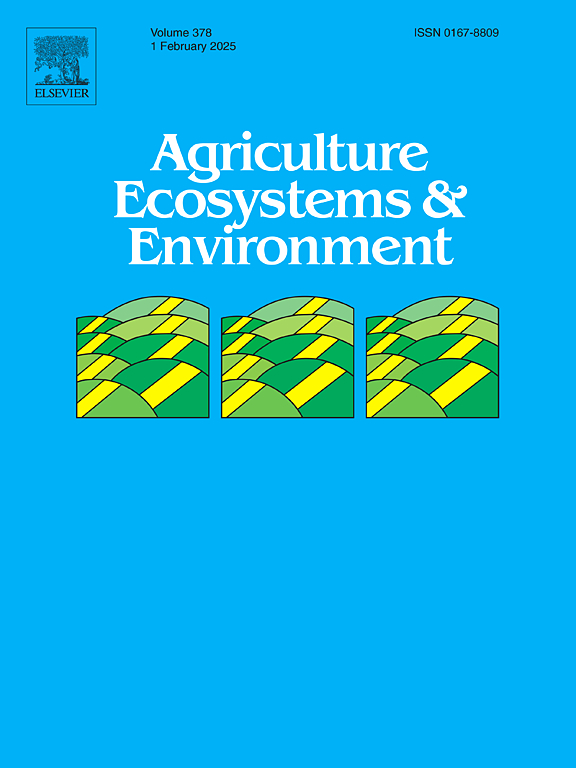中国东北地区粮食-水-土地效益的权衡与协同,促进轮作优化
IF 6.4
1区 农林科学
Q1 AGRICULTURE, MULTIDISCIPLINARY
引用次数: 0
摘要
在农业管理中,选择适当的轮作类型(CRT)对可持续发展至关重要。尽管人们关注粮食生产、水资源保护和农田保护,但对不同轮作类型下粮食、水和土地之间的相互关系和效益却缺乏系统的定量分析。这一差距阻碍了目标的实现,限制了对农业规划的有效支持。本研究利用产量、用水效率(WUE)和农田退化与恢复(FDR)条件来衡量与粮食生产、水资源保护和农田保护相关的效益。以中国东北地区(NEC)为例,确定了九个主要 CRT 区,并对其 "粮食-水-土地 "综合效益进行了定量评估。研究结果表明,不同 CRT 区的年平均产量和 WUE 存在显著差异。具体而言,玉米连作区或水稻连作区的平均产量远高于大豆连作区;大豆连作区的 WUE 最高,多年平均值为 1.105 kg-C-m-3。用于 FDR 检测的 NPP-WUE 框架表明,轮作比连作更有利于农田保护,因为检测到的恢复面积比例更高。通过评估作物轮作与 "粮食-水-土地 "效益之间的权衡,结果表明,在优先考虑粮食生产、水资源保护或农田保护等单一目标时,农田的最佳作物轮作分别是玉米-连作、大豆-连作或大豆-其他作物轮作。如果考虑到多重目标,玉米连作或大豆连作最为理想。因此,在非集中连片区保持大面积玉米种植,同时扩大大豆种植面积是合理的。我们建议在国家经济区调整玉米-大豆连作和水稻-连作;前者优先转向玉米或大豆连作,后者优先转向玉米-水稻轮作。这项研究为权衡和优化轮作模式提供了宝贵的见解,从而促进了农业的可持续发展。本文章由计算机程序翻译,如有差异,请以英文原文为准。
Trade-offs and synergies of food-water-land benefits for crop rotation optimization in Northeast China
In agricultural management, selecting the appropriate crop rotation type (CRT) is crucial for sustainable development. Despite the focus on food production, water conservation, and farmland protection, systematic and quantitative analyses of the interrelationships and benefits among food, water, and land under different CRT scenarios are lacking. This gap hinders the achievement of goals and limits effective support for agricultural planning. This study utilized yield, water use efficiency (WUE), and farmland degradation and restoration (FDR) conditions to measure benefits related to food production, water resource conservation, and farmland protection. Taking the Northeast China (NEC) region as an example, nine major CRT zones were identified, and their integrated "food-water-land" benefits were quantitatively assessed. The findings revealed that there are significant differences in the annual average yield and WUE under different CRTs. Specifically, the average yield of the Maize-continuous-cropping or Rice-continuous-cropping zone is much higher than that of the Soybean-continuous-cropping zone; the WUE was highest in the Soybean-continuous-cropping zone, with a multi-year mean of 1.105 kg·C·m−3. The NPP-WUE framework for FDR detection indicated that crop rotation is more conducive to farmland protection than continuous-cropping, as a higher proportion of restoration area was detected. By assessing the trade-offs between CRT and "food-water-land" benefits, the results show that when prioritizing a single goal of food production, water resource conservation, or farmland protection, the best CRT for farmland is Maize-continuous-cropping, Soybean-continuous-cropping, or Soybean-Other crops rotation, respectively. When multiple goals are considered, Maize-continuous-cropping or Soybean-continuous-cropping is the most ideal. Therefore, maintaining a large area of maize while expanding soybean planting in the NEC is reasonable. In the NEC, we recommend adjusting Maize-Soybean and Rice-continuous-cropping; the former prioritize shifting to Maize or Soybean continuous-cropping, and the latter prioritizes shifting to Maize-Rice rotation. This study offers valuable insights into the trade-offs and optimization of CRTs, thereby contributing to sustainable agricultural development.
求助全文
通过发布文献求助,成功后即可免费获取论文全文。
去求助
来源期刊

Agriculture, Ecosystems & Environment
环境科学-环境科学
CiteScore
11.70
自引率
9.10%
发文量
392
审稿时长
26 days
期刊介绍:
Agriculture, Ecosystems and Environment publishes scientific articles dealing with the interface between agroecosystems and the natural environment, specifically how agriculture influences the environment and how changes in that environment impact agroecosystems. Preference is given to papers from experimental and observational research at the field, system or landscape level, from studies that enhance our understanding of processes using data-based biophysical modelling, and papers that bridge scientific disciplines and integrate knowledge. All papers should be placed in an international or wide comparative context.
 求助内容:
求助内容: 应助结果提醒方式:
应助结果提醒方式:


